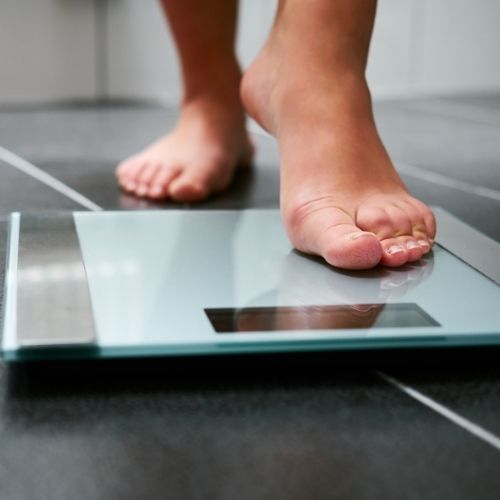Do you know how to use BMR to lose weight? In fact, how do you calculate BMR, and what is BMR?
When it comes to weight loss, there are a lot of factors that come into play. Two of the most important ones are your basal metabolic rate (BMR) and your calorie intake.
In this blog post, we show you how to use BMR to lose weight and how to calculate it. So let’s get started!
What Is BMR?
BMR stands for “Basal Metabolic Rate”. It can be described as the total energy that your body needs to keep life-preserving processes active.
Life preserving processes are:
- Breathing
- Beating of the heart
- Digestion
- Purifying blood through the kidneys.
- Keeping the temperature of the body regulated
BMR can change during different phases of life. For example, a teenager going through puberty will have a higher BMR when compared to an adult in their mid-20s.
Teenagers need a lot of energy because they are rapidly growing. Adults, on the other hand, have lower BMRs because they have stopped growing and only need to sustain their bodies.
Furthermore, BMR during any single phase does not change. Adults may have the same BMR for years on end. Your BMR depends on a person’s age, height, weight, gender, and lean mass.
How To Calculate BMR And Use It Lose Weight
BMR can be calculated most precisely by a lab test. This test involves a “Calorimetry” test in which the patient has to fast for 12 hours and during the examination, their oxygen usage and carbon dioxide production are measured.
These statistics are used to accurately calculate how much energy is being used for vital life functions.
Alternatively, there is an easier but less accurate method. You can just use an equation to calculate your BMR. There are approximately 248 such equations (according to a study in 2013). Let’s check out a few of these equations.
- Harris-Benedict Equation
Men’s BMR = 88.362 + (13.397 * weight in kg) + (2.799 * height in cm) – (5.677 * age in years)
Women’s BMR = 447.593 + (9.247 * weight in kg) + (3.098 * height in cm) – (4.440 * age in years)
- Mifflin-ST Jeor Equation
Men’s BMR = (10 * weight in kg) + (6.25 * height in cm) – (5 * age in years) + 5
Women’s BMR = (10 * weight in kg) + (6.25 * height in cm) – (5 * age in years) – 161
- Katch-McArdle Equation
BMR = 370 * (21.6 * Lean Body Mass)

The Katch-McArdle equation requires you to know your fat percentage. Lean mass is found by multiplying the fat percentage by your body weight and then subtracting it from the body weight.
Alternately you can use an online BMR calculator to find out your BMR. All you need to do is to provide it your age, height, weight, and gender. It will automatically calculate your BMR.
How To Use BMR To Lose Weight
The logic behind losing weight is to cause an energy shortage in your body. When your body is not receiving the amount of energy it needs, it will start using the stored fat.
Stored fat is the extra fat that your body deposits mostly underneath the skin to act as an insulator and around organs to act as a shock absorber.
Losing too much of this fat is not good for you. However, if you are looking to lose weight, chances are you have too much of it, which is also not good.
Energy deficit can be created by consuming fewer calories than what your body uses on a daily basis.
TDEE
The energy used by the body daily is called “Total daily energy expenditure” or TDEE. Your BMR makes up almost 70% of your TDEE. It can be critical to managing your daily Energy level, we use a free online tool like TDEE and the related tools for boosting your health curiosity from calculator-online.net.
To calculate TDEE you need to multiply your BMR by one of the following modifiers:
- Sedentary lifestyle:
BMR * 1.2 = TDEE.
- Light exercise 1 to 3 days a week:
BMR * 1.375 = TDEE.
- Moderate exercise 3 to 5 days a week:
BMR * 1.55 = TDEE.
- Hard exercise 6 to 7 days a week:
BMR * 1.725 = TDEE
- Hard exercise every day or a highly demanding physical job:
BMR * 1.9 = TDEE
TDEE can vary from day to day, so you will need to find an average first. Once you have found your average you can start monitoring your diet.
Losing Weight
Your objective should be to consume at least 500 calories less than your average TDEE. According to experts, if you do that you will lose at least 1 pound of fat per week.
This method does not apply to those whose TDEE is very low though. A person whose TDEE is 2500 calories can easily adjust and safely reduce 500 calories from their meal.
But a person whose TDEE is only 1600 will have problems like weakness and fainting if they were to reduce their calory intake by 500. In that case, they shouldn’t reduce their intake by 500.
Instead, they should start by removing 100 or 200 calories. After a week they should have an analysis to check if they are losing lean mass. If they aren’t then everything is fine otherwise, they should stop dieting.
Another method to cause a calorie deficit is to increase the energy expenditure while consuming the same amount. They should also eat less fatty food and consume more proteins.
Eating more proteins during dieting ensures that the weight you lose is fat mass and not lean mass.
Losing lean mass is detrimental to your health. It may result in weaker bones and weaker organs. That can be very dangerous and, in some cases, lethal.

Conclusion
In this article, we learned how to use BMR to lose weight, and some methods to calculate BMR.
BMR stands for basal metabolic rate and can be defined as the amount of energy (measured in calories) that our body requires to maintain important life functions.
We looked at a few equations that are used to measure the basal metabolic rate. For example, the Harris-Benedict equation and the Katch-McArdle equation. These equations can provide a good estimate of your BMR.
We learned what is total daily energy expenditure (TDEE). BMR plus any energy used for exercise and physical activity is your TDEE.
Eating fewer calories than your TDEE can make you lose weight. Increasing your TDEE while eating the same number of calories can also make you lose weight.
We hope you find this article helpful, and for more weight loss tips, our article – Quick Ways To Lose Weight: Tips for Busy Moms may be helpful.
Our super author here at Famous Parenting and an absolute wealth of knowledge. She has studied many topics including creative writing, psychology and journalism but her real passion lies in raising her 3 children. Between working from home, homeschooling her youngest 2 children and navigating the world of teenagers she is a guru for parents.





